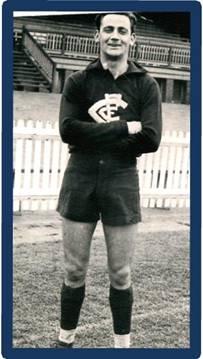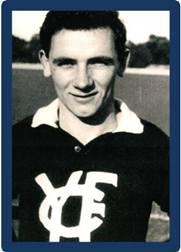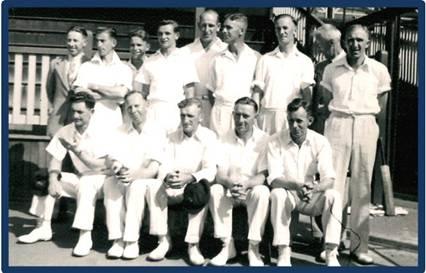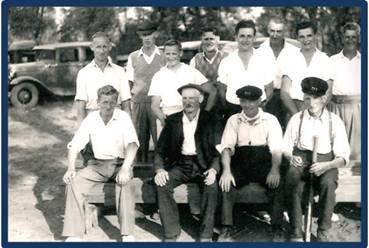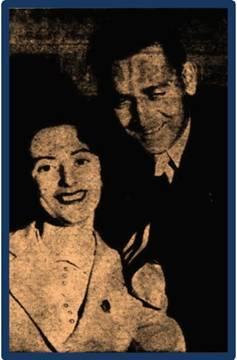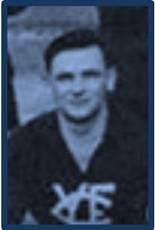Sydney and Frances Williams had six children Keith, Lorna, Allan, Doug, Betty and Morris. In the early years, Sydney worked a small farm in the Hill End-Willow Grove area.
“Syd provided a supporting role to the running of the family store and hotel, using horse and carriage passenger and mail services (Cobb & Co. style) to all parts of the surrounding areas linking to Moe. In the 1920’s, the horses were replaced with motor vehicles.” …Morris Williams.
Sometime in 1930’s the family moved into Yallourn and the story of two of Yallourn’s best-ever footballers starts here.
DOUG WILLIAMS
Doug (born in 1923) attended Yallourn State School (4085) and YTS and then commenced his apprenticeship in boiler-making and welding. It was in his teenage years that Doug was identified as a talented sportsman, particularly in football and cricket.
THE CENTRAL GIPPSLAND WAR TIME LEAGUE
During World War:II, Doug came under notice as a player of significant potential. Football historian Ian Shaw wrote in 2006 that…
“…the local competition had been suspended for the duration of the War but…. matches were organized on an informal basis.” This football competition was known as ‘The Central Gippsland War Time League’ and Doug’s brilliance for Yallourn FC in those matches could not be ignored.
Local identity, Bert Downs (the brother of noted Carlton rover Tom Downs) recommended that Doug train at Carlton FC. The Blues wasted no time in signing Doug and he played his first senior game against Footscray in Round: 11 in 1944. Doug had three qualities that captured the imagination of the Carlton fans. These were his unflinching courage in tough contests, his pin-point kicking and his pace. Doug seemed to be a natural wing man and he soon won the ‘nod’ of the selectors and he became a regular and valued member of the Blues’ midfield.
In 1945, Doug played in nineteen matches for Carlton which says a great deal about his fitness, resilience and consistency in the VFL ranks. By 1950, he had forged a strong reputation as one of the best wing men in the league. Percy Taylor of ‘The Argus’ wrote….
“…courage, tenacity and good disposal are the chief characteristics of his play. He is the type of player that most clubs are keen to have about the place as he is reliable, reserved and an excellent club man at Carlton.”
Doug played in two senior grade VFL Premierships (1945 & 1947) and he also played in a reserves premiership with Carlton in 1951.
THE 1945 BLOODBATH GRAND FINAL
The 1945 Grand Final against South Melbourne was to become known as the Bloodbath and it is said to have been…
“One of the roughest, toughest and bloodiest of all VFL football finals and, mainly for that reason, it will not be quickly forgotten.”
Carlton 15.13 (103) defeated South Melbourne 10.15 (75). 10 players were reported that day and it is said that police officers entered the playing arena at various stages to restore order. It was a black mark against the great game of Australian Rules football. The great pity is that people remember the fights and tend to overlook the well-deserved 28 point win by Doug’s team.
Doug played on the wing that day. His opponent was Joe King. Both Joe and Doug showed great restraint. Neither became embroiled in the fierce brawling and violent clashes which marred the game. Later when the dust had settled and ‘peace was proclaimed’, Joe King praised Doug for his sportsmanship, self control and discipline in the ‘heat of battle’.
A highlight of Doug’s VFL career was the Blues’ one point win over Essendon in the 1947 Grand Final against Essendon. In front of 85,815 fans, Carlton came from behind at three-quarter time to snatch an amazing win. History shows that in the dying seconds of the game, Carlton’s half forward flanker, Fred Stafford, took possession of the ball and snapped a left foot major to clinch the match. Carlton won the 1947 flag by the narrowest of margins and Doug was to tell a reporter from ‘The Tasmanian Examiner’ in a later interview that…
“It took quite a while to realize that we had won…and just as long for Essendon to realize that it had lost the pennant.”
In January 1949 it was reported in ‘The West Australian’ newspaper that…
“…at least three clubs (WAFL) are trying to persuade the Victorian footballer (Doug) to remain in this state (WA).”
Doug also played for Carlton in the 1949 Grand Final against Essendon. On that occasion champion full forward John Coleman ‘bagged’ six goals to set up a convincing win for the Bombers. The Essendon team included such VFL greats as Dick Reynolds, Bill Hutchinson, John Coleman and Bill Brittingham.
Despite the loss it must have been a thrill for Doug to have played before a packed stadium of more than 90,000 fans. He played his 100th senior VFL match against Geelong in Round: 17 of the 1949 season. Doug was often mentioned in newspaper reports and one ‘scoop’ carried in ‘The Argus’ in 1950 centred about Doug being hospitalised to have his tonsils removed.
HIS LAST GAME WITH HIS BROTHER MOSSIE
One of the greatest thrills of Doug’s life in football was when he played with his brother Morris (aka ‘Mossie’) in the 1951 VFL Reserves Grand Final. Carlton defeated Essendon to win the premiership. Doug was a major contributor to the Blues’ win. It was something that Doug and Morris cherish when looking back at their time at Carlton Football Club. Although Ken Aitken was the team captain, Carlton FC history revels that Doug Williams “was the master of the MCG that day”.
Doug played a major role assisting the development of younger Carlton brigade that year and ‘showed by example’ the standards required to succeed at VFL football.
Doug retired from VFL football in 1951. He had played 120 games and kicked 7 goals in a distinguished career that had commenced in 1944. Doug gathered a total of five Brownlow Medal votes during his VFL career.
It was reported in ‘The Hobart Mercury’on the 13th December 1951 that Doug had been awarded Life Membership of the Carlton Football Club.
After his departure from Carlton’s Princes Park, Doug’s famous number 12 jumper was handed to a young recruit named Tony Walsh (ex-Geelong).
TASMANIA & MORWELL
In 1952, Doug accepted an offer to coach North Launceston (NTFL). He was an astute coach and was successful in leading his team into the NTFL final series that season. He was also selected for the NTF Association match against the TFL in Hobart that year.
At the end of that season, Doug and his wife, Margaret, decided to ‘head home’ and the officials and supporters of the North Launceston FC held a special farewell gathering for Doug. It was reported that more than 150 ‘well wishers’ attended the function. In his last speech to the club’s faithful supporters, Doug said…
“...give and take on the football field, as in every walk of life, was more important than any premiership”.
That statement reflects Doug’s character and spirit. He was a gentleman and a man of honour in all walks of life.
THE 1953 CGFL GRAND FINAL
On February 19th 1953, ‘The Morwell Advertiser’ reported that the former Yallourn and Carlton star, Doug Williams, had signed to play with Morwell FC in the CGFL. It was a ‘recruiting coup’. The announcement probably caught Yallourn FC officials and supporters by complete surprise.
Doug starred for Morwell during that season. Briefly, Morwell won the right to play Yallourn in the 1953 Grand Final. The Grand Final was a ‘nail-biting’ tie. The Grand Final Replay, the following week at Trafalgar, went right ‘down to the wire.’ It is said that the Replay was one of the greatest contests ever seen in Gippsland football.
Morwell hung on to win the titanic struggle by five points. Believe it or not, when the siren sounded to end the match, Doug Williams had possession of the ball. The climax of that battle could not have been scripted in a Hollywood studio any better. There is no doubt that the symbolism of that ‘moment of defeat’ would not have been overlooked by the disappointed Yallourn supporters. Doug won Morwell’s Best and Fairest Trophy that season. He also polled 11 votes in the Rodda Medal. Doug’s great friend in life and Yallourn’s champion rover, Jimmy Shaw, won the Medal by one vote from Noel Ross (Mirboo North).
The 1953 Grand Final was Doug’s last game of football and he hung up his boots at the end of the season. In what could only be described as a dazzling career, Doug Williams took a well earned rest from the game. He had given much to CGFL, LVFL, VFL and Tasmanian football and had always been a role model for younger sportsmen. It is written in the archives of Carlton Football Club that Doug was…
“…widely regarded as one of the better centre-line of the post- war years”.
Note: 1. Jack Aitken and Jack Vinall, who had played for Morwell FC in1953, were both cleared to Yallourn in 1954. Jack Aitken took over the coaching role at YFC from Frank Kelly in that season. Jack Vinall went on to play in excess of 100 senior games and about 120 reserve grade games for YFC.
Note: 2. The exhilarating Grand Final Replay between two great football rivals brought the curtain down on the CGFL. History shows that on April 24th 1954, the newly formed LVFL became the major Gippsland league and great change was afoot in regional football.
MORRIS ‘MOSSIE’ WILIAMS
EARLY YEARS
Morris ‘Mossie’ Williams was born in 1929 and the early signs indicated that Mossie was a boy of immense ability in ball games and athletics. He was born into a family that enjoyed outdoor recreation and Mossie loved all sports particularly football.
Mossie gained prominence as a youngster in local football and was selected to play his first senior game for YFC at 17 years of age. He remembers that Bill Godfrey was his first senior coach. He quickly gained a reputation as a skilled and hard running wingman in the CGFL. Mossie recalls Geoff Collins starring for the Blues in those years. (Note: Geoff later played with Melbourne/Victoria and skippered the Demons in 1954).
TED HILL & THE 1948 PREMIERSHIP
Mossie recalls that the arrival of Ted Hill (ex-Collingwood/Fitzroy) as YFC coach in 1948 had a positive impact on his football. It is known that Ted was a coach of great knowledge and insight. He still remembers how Ted would often sit with him and quietly discuss the subtle points of football and the fundamentals of wing play. Mossie thought that Ted was a fine communicator and an inspiring coach. Stan Brown, Alan McIntyre, Don Benson, Harry Vanderbist, Jim Shaw, Bill Godfrey, Simon Shaw, Bernie Nairn and Morris formed the nucleus of a strong team for Yallourn in that era.
Mossie played on the wing in the Blues’ premiership team that defeated Morwell by 14 points at Trafalgar in 1948. The final scores were: Yallourn 7.11. (53) defeated Morwell 6.3.(39). Yallourn’s best players that day were were: Pete Harries, Jack Taylor, George Looby, Stan Brown, Ted Hill, Bill Godfrey, Jimmy Shaw, Charlie Vanderbist and Bill Shaw.
Ted and his victorious team were the ‘talk of the town’ after that convincing and historic win over the Tigers. According to the reports in ‘The Morwell Advertiser’ that year, the celebrations led by YFC President, Jack Collins (ex-Melbourne FC), were grand and impressive events.
(Note: The 1948 CGFL flag was to be Yallourn’s last premiership in either the CGFL or the LVFL).
Mossie recollects that he had a great battle with Morwell’s Neil Denier on the wing that day. Both played well, however Mossie must have impressed the critics as he was recruited by Carlton for the start of the 1949 VFL season. (Note: Neil Denier went onto play almost 150 games as a wing man and back pocket for Morwell in a career that spanned 8 seasons).
PLAYING FOR CARLTON FC
‘The Argus’ (8th April 1949) reported that Mossie had been chosen to play in the senior practice match at Carlton. In a surprise announcement that stunned the club, Yallourn FC also lost the services of Ted Hill, who was appointed coach of Ulverstone FC in Tasmania.
The decision to sign with Carlton presented some difficulties for Mossie, as he was working with the SECV in Yallourn (as a turner and fitter). Consequently, he travelled by steam train each Friday during the football season to play with Carlton.
(Note: The steam train trip to Melbourne was testing for all travellers. The train rarely had time to gather speed as it stopped at all stations between Moe and Flinders Street. The trip was hardly the ‘best preparation’ to play VFL football).
In 1950 Mossie was transferred to the SEC Power Station in Green Street, Richmond and his football went ahead in ‘leaps and bounds’. He played with the Carlton reserves for four seasons and was often mentioned in match reports. Mossie remembers being chosen for the seniors to play in the VFL Lightning Premiership in the early 1950’s. Mossie remembers that…
“…it was a great experience to play with Carlton FC…. applying myself to the game in the best way I could and the challenge of the ‘big city’ living. Having my brother, Doug, there was great and it made it much easier for me. Not only did my game develop but as well, I established lots of lasting friendships along the way”.
Undoubtedly, a major highlight of his years at Carlton FC was being a member of the 1951 VFL reserves premiership team. In that season, Carlton, coached by club stalwart Mick Price, played Essendon in the VFL Reserves Grand Final. Mossie (wearing number 5 that day) was selected on the half back flank, while brother Doug played on the wing. The Carlton team included some well known names in VFL history including George Ferry, Dick Gill, Bill Milroy (later to coach Trafalgar in the LVFL), Bernie Baxter, Gerald Burke and Doug Beasy.
In front of a massive crowd of 82,890, Carlton 8.15. (63) defeated Essendon 7.9. (51). Mossie was part of a well drilled and desperate Carlton defence which kept Essendon’s talented forward line to only 7 goals that day. The match was umpired by Harry Beitzel who, in time, would become a radio commentator and media personality. It was a significant victory for Carlton and the Williams brothers. It was the last game that Doug and Mossie would ever play together.
RETURN TO YALLOURN
Doug left to coach in Tasmania in 1952 but Mossie stayed on at Carlton for two more seasons. His return to Yallourn in 1954 was marked with great interest and anticipation by the town and the Blues’ supporters. (Note: Jack Aitken was appointed the coach of YFC in 1954).
In April 2013, Mossie wrote about his time settling back into Yallourn after his Melbourne experience…
“Yallourn had wonderful personalities, characters, retired football club identities and their families supporting the YFC, I suppose as they did in all other sports at Yallourn. Sporting club stalwarts were there to be seen helping to create a most friendly and relaxing club atmosphere. I enjoyed my time immensely during these years...providing me with the opportunity of rebuilding my ‘old’ friendships and more after an absence of nearly five years.”
In closing Mossie asked… “What else would you need to succeed?”
Mossie was a ‘stand out’ player in the newly formed LVFL league and his style, speed and skill grabbed the attention of spectators, reporters and umpires.
His consistent form in 1955 was a contributing factor to Yallourn, winning its way to the LVFL Grand Final against Sale that year. Mossie enjoyed his football that season and he was very impressed with Gerald Marchesi’s style of leadership and he appreciated his coaching methods. ‘The Argus’ on June 3rd 1955 announced the LVFL team to play the Gippsland League at Morwell that season. Only two players from Yallourn were chosen for the LVFL combine. Laurie Shipp was selected in the back pocket (change-ruck). Mossie was named on the wing. Hugh Murnane (Sale) was the coach of the LVFL and John Coffey (Ex-St Kilda/Victoria) was captain. Former Yallourn FC star/ex-Melbourne skipper Geoff Collins and Bill Young (Stratford/St Kilda) were named in the Gippsland team.
A late season ‘winning’ streak saw the Blues sneak into fourth place on the LVFL ladder. The Blues were the ‘wild card’ in that final series. A large crowd of 7,342 crammed into the Morwell Oval that day to witness the thrilling encounter. YFC started as the ‘underdogs’, against the highly fancied and powerful Sale combination and went within a ‘whisker’ of winning the premiership. The battle between Yallourn’s centre line (Claude Whitbourne, Mossie Williams & Ray Kitney) and the talented Sale trio of Darby Orchard, Bob Jones and Maurice King was pivotal to the outcome. Despite a scintillating first half, Yallourn’s inability to score goals in the third term let Sale back into the game. The Magpies led by Bob Mason, Ian Brewer and Alan Morrow hung on in dying stages to take the 1955 pennant. The final scores that day were Sale 11.13. (79) defeated Yallourn 10.9. (69).
Yallourn’s best players as listed in ‘The Argus’ (12th September) were Gerald Marchesi, Mossie Williams, Jim Shaw, Bruce Knight, Keith Gibson, Kevin Fanning, Barry Coad and Laurie Shipp. Roy Cullinan kicked four goals, Peter Cook (who later played with Melbourne FC) and Gerald Marchesi each kicked two goals for the Blues.
It was to be the last final that Mossie would ever play for Yallourn FC.
A MEMORABLE SEASON 1957
Morris won high praise from the locals for his sustained brilliance and dominating play across the centre-line in 1957. It was a stellar season for Mossie and although John Nix (Sale/ex-Richmond) won the Trood/Rodda Medal, Mossie was one of the indisputable stars of LVFL football that season.
He also tied with Warragul’s Maurie Reeves (ex- Melbourne) in ‘The Hinkley Stores Award.’ Both players polled 21 votes and Alan Morrow (Sale) finished third with 15 votes.
To further underline his consistent form in 1957, Mossie finished runner-up to the Blues’ mighty follower Bruce Knight in the YFC’s Best and Fairest Trophy.
Mossie retired from football at the age of 29. It had been an auspicious career in country football and a satisfying stint in VFL. A nagging injury didn’t make his football any easier but Mossie was never one to complain. Injury is part of the game and most footballers live with the ‘millstone’ of never being fully fit. Unfortunately, it is the nature of contact sport.
In all, Morris played about 70 senior games and kicked 20 goals (approx) for YFC.
ATHLETICS, KEITH AND MEMORIES OF YALLOURN
Some readers may be unaware that Mossie, like his brother Keith, was an outstanding sprinter and trained for the various country gift meetings, including Stawell, under the tutelage of Bill Coleman (a legend in Victorian professional running in those days).
It was reported in ‘The Morwell Advertiser’ (March 31st 1938) that Keith won the ‘ANA Yallourn Gift’. He also won the 75 yard ‘Latrobe Sprint’ on the same day. It was quite an achievement in athletics to win ‘the double’ at the same athletics meeting. Keith was one of Gippsland’s leading athletes in that era.
Keith was also active in the Yallourn Fire Brigade. Keith’s background in athletics was of great advantage to the Yallourn Brigade members in their training drills in preparing for the State-wide Competitions which were so popular in that period. Mossie also remembers that Keith was a handy footballer for the Yallourn Golds in those years when YFC had two senior football teams.
Mossie was fortunate to have found the right balance between sport, work and home-life. Like many former YFC footballers interviewed for this project, Mossie thought that Yallourn was a wonderful place for people, sport and family life. From his earliest days at school until his retirement from the SEC, after 45 years of service, Mossie remains eternally grateful for the opportunities that living in Yallourn created for his family.
Little did Syd and Frances Williams know where their decision to shift to Yallourn would take their family in the ‘scheme of things.’ They could never have guessed that their sons Doug and Morris would both play for Carlton FC and would become regarded as two of the YFC’s greatest and most popular players of all time.
FOOTNOTES.
1. At the time of writing this story, Doug and his wife Margaret were living in Inverloch and Mossie and Denise were residents of Morwell.
2. A Special Edition of the Australian Postage Stamp ‘The Premiership Players Club’ depicting Doug Williams was released in 2007. See the graphic related to this story.
3. Mossie also played in the Country Week Cricket Carnival in Melbourne as a batsman. A photo of Mossie and the team is posted with this story.
4. In the 1946-47 season, Yallourn Cricket Club defeated Moe Golds by 10 wickets in the Y&DCA Grand Final. Keith, Doug and Mossie played for Yallourn CC in that match. Doug was the star of the Final, taking 5 wickets for 13 runs and making 38 runs (the top score for his team). Other well known Yallourn sporting identities included in that team were Don Benson, Andy Smith and Tim McCoy.
5. The stories of Ted Hill and the 1948 premiership win have been prepared and will be posted on the Virtual Yallourn website at a future date.
6. The story of 1955 Grand Final has been written and will be posted on the website.
7. Other stories regarding Gerald Marchesi and other players of that era can be found on www.virtualyallourn.com.
8. ‘The Bloodbath’ written by Ian Shaw is available through Municipal libraries.
9. Bert Downs coached Yallourn FC in 1946
10. Readers may be unaware that the C.H. Williams Reserve at Willow Grove is named in honour of Mossie’s Grandfather, Mr Charles Henry Williams.
A VERY SPECIAL THANK YOU
A special note of appreciation to Mossie Williams for his kind assistance in validating the above research regarding Doug and his family. Mossie gave a great deal of time in discussing his football, his work and family for this project. He was most generous in providing photographs and a documented history of his family for research purposes.
Written for Virtual Yallourn by Roger Spaull ~ April 2013
For further stories, photographs and memorabilia regarding YFC…click ‘Search’…type ‘Football’ and press ‘Enter.’
Yallourn Football Club YFC - Doug Williams on Special Edition Stamp
A Special Edition Postage Stamp depicting Doug Williams. The Eighth Annual Issue 2007 in Australia Post's Series of "The Premiership Players Club Inc"
Yallourn Football Club YFC - Mossie Williams at the Victorian Country Week Carnival
Mossie Williams at the Victorian Country Week Carnival - other well known Yallourn sporting identities included in the photograph are - Ben Pavlich, Dick Sagar, Joe Carroll, Bert Badley, Harold Graham, Don Benson, Jack Collier and Phil Ashmead
Yallourn Football Club YFC - The Williams' Family Cricket Team
The Williams' Family Cricket Team in 1945. This photograph was taken at Willow Grove when the Williams' family played 'The Rest'.
Back Row: Colin, Cyril, Keith, Eric, Doug, Lad, Mossie, Jack
Front Row: Alan, Bert, Syd, Reube
Yallourn Football Club YFC - Doug & Margaret Williams
Doug and Margaret Williams pictured in Launceston in December 1951. The photo was carried in a newspaper article in relation to Doug accepting the coaching position at North Launceston FC for the 1952 football season.


